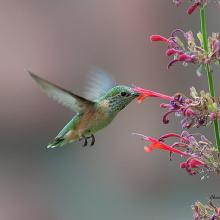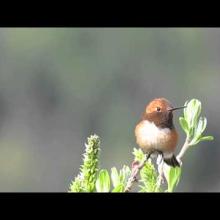

Join BirdNote tomorrow, November 30th!
Illustrator David Sibley and actor H. Jon Benjamin will face off in the bird illustration battle of the century during BirdNote's Year-end Celebration and Auction!
In April 1778, the explorer James Cook and his crew spent most of the month at anchor in Nootka Sound, off present-day British Columbia. The native people were eager to trade with the Englishmen. According to the British ornithologist Thomas Pennant, Rufous Hummingbirds were among the commodities offered, and the natives delivered them to the crew, “alive, with a long hair fastened to one of their legs.” That detail was omitted from reports of Cook’s voyages. But it’s a striking image: little red birds surrounded by curious sailors, captive at the end of their tenuous tethers.
BirdNote®
Hummingbirds, By a Hair
Written by Rick Wright
This is BirdNote.
On the way to his fatal encounter in Hawaii, the explorer James Cook and the crew of the ship Resolution spent most of April 1778 at anchor in Nootka Sound, off present-day British Columbia.
[Rufous Hummingbird, ML 193479, 00:06 ff.]
The inhabitants of what is now Vancouver Island were eager to trade with the Englishmen, offering them luxurious furs and other precious commodities. And birds, noted Cook, “in great numbers.”
[Rufous Hummingbird, ML 109124, 00:05 ff.]
Among the feathered treasures was a new hummingbird. The discovery of this rusty-colored sprite, which the natives called sasin (ZAY-zin), extended the known range of this “tropical” family surprisingly far to the north and west.
[Rufous Hummingbird, ML 109124, 00:05 ff.]
According to the British ornithologist Thomas Pennant, who wrote the formal descriptions of many of the birds that returned on Cook’s ships, some of those hummingbirds were delivered to the crew still breathing. The natives, Pennant wrote, “brought them to our navigators alive, with a long hair fastened to one of their legs.”
That detail was omitted from the official report of Cook’s voyages. But it’s a striking image: little red birds surrounded by curious sailors, captive at the end of their tenuous tethers.
For BirdNote, I’m Michael Stein.
###
Bird sounds provided by The Macaulay Library of Natural Sounds at the Cornell Lab of Ornithology, Ithaca, New York. Rufous Hummingbird [193479] by Richard Nelson; Rufous Hummingbird [109124] by Geoffrey A. Keller.
BirdNote's theme music was composed and played by Nancy Rumbel and John Kessler.
Producer: John Kessler
Executive Producer: Dominic Black
© 2016 Tune In to Nature.org June 2016 Narrator: Michael Stein
ID# RUHU-11-2016-06-14 RUHU-11








